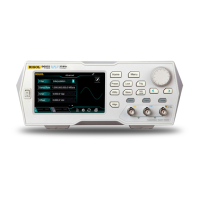Chapter 2 Command System RIGOL
DG800 Programming Guide 2-103
Mod/Trig/FSK] connector. Positive signal level corresponds to frequency increase, and negative
signal level corresponds to frequency decrease. Lower signal levels produce less deviation. For
example, if the frequency deviation is set to 1 kHz, +5 V signal level corresponds to a 1 kHz increase in
frequency and -5 V signal level corresponds to a 1 kHz decrease in frequency.
Return Format
The query returns the frequency deviation in scientific notation, with 7 effective digits. For example,
1.000000E+02 (the frequency deviation is 100 Hz).
Example
:SOUR1:FM 100 /*Sets the FM frequency deviation of CH1 to 100 Hz.*/
:SOUR1:FM? /*Queries the FM frequency deviation of CH1 and the query returns 1.000000E+02.*/
[:SOURce[<n>]][:MOD]:FM:INTernal:FREQuency
Syntax
[:SOURce[<n>]][:MOD]:FM:INTernal:FREQuency {<frequency>|MINimum|MAXimum}
[:SOURce[<n>]][:MOD]:FM:INTernal:FREQuency? [MINimum|MAXimum]
Description
Sets the FM modulation frequency of the specified channel.
Queries the FM modulation frequency of the specified channel.
Parameter
Remarks
This command is only applicable to the internal modulation source
(
[:SOURce[<n>]][:MOD]:FM:SOURce).
When [:SOURce[<n>]] or [<n>] is omitted, the system sets the related parameters of CH1 by default.
Return Format
The query returns the FM modulation frequency in scientific notation, with 7 effective digits. For example,
1.500000E+02 (the FM modulation frequency is 150 Hz).
Example
:SOUR1:FM:INT:FREQ 150 /*Sets the FM modulation frequency of CH1 to 150 Hz.*/
:SOUR1:FM:INT:FREQ? /*Queries the FM modulation frequency of CH1 and the query returns
1.500000E+02.*/

